This book constitutes the refereed proceedings of the 14th International Conference on the Quality of Information and Communications Technology, QUATIC 2021, held in Algarve, Portugal*, in September 2021.
The 30 full papers and 9 short papers were carefully reviewed and selected from 98 submissions. The papers are organized in topical sections: ICT verification and validation; software evolution; process modeling, improvement and assessment; quality aspects in quantum computing; safety, security, and privacy; quality aspects in machine learning, AI and data analytics; evidence-based software quality engineering; quality in cyber-physical systems; software quality education and training.
*The conference was held virtually due to the COVID-19 pandemic.
